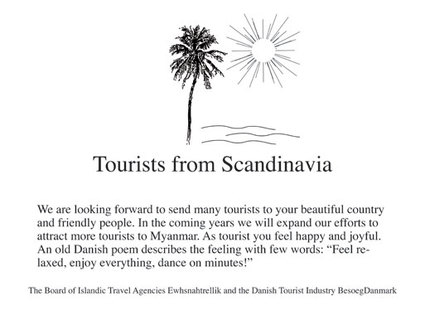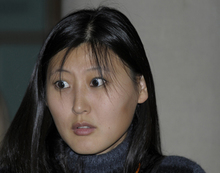Ode to Misunderstanding
Writing a text about misunderstandings is a dangerous undertaking – even if that text is a report which, because it purports to be objective, contains only the smallest quota of misunderstandings. But this report by an observer was deliberately intended to be subjective; misunderstandings and inaccurate comprehension are likely to be inevitable. Unless, of course, I achieved a total absence of ambiguity in my choice of language – something which, according to the late Wittgenstein, language can simply never offer. Nevertheless, I shall try. My theses are threefold:
1. Thesis: Art shocks reality
Misunderstandings, as Sharon Fernandez said at the plenary session in the Kaufleuten club room – a silky-red space with opulent baroque furniture which erroneously suggested that we were going to see a variety show (brains are only crushed on hard wooden chairs) – misunderstandings are an expansion of reality; a definition to which, just an hour and a half later during the podium discussion on “Misunderstandings as an artistic strategy”, Yvette Sánchez added: Misunderstanding (or error) should be seen no longer as a sign of failure, but rather as a creative principle. “Error in fact acts more as a catalyst,” write Sánchez and Ingold in Mistakes in the System: Error, Deficit and Catastrophe as Factors in Cultural Productivity (1), since error requires a corrective intervention that promotes experimentation: “As an antidote to normalized systems, errors fulfil a productive, disruptive function.” (2)
Now misunderstandings are a very specific type of error: in everyday situations they are often perceived not as errors but rather as pardonable slips, misguided connections that come about due to sloppiness or carelessness – or perhaps because different meanings are ascribed to identical terms. And that, for most people, is not an error, but rather a (perfectly natural) small and venial mistake. So is the concept of “misunderstanding” itself burdened with the misunderstanding of being taken for a non-error when in fact it is one?
Of course, one could also say that misunderstandings are not in fact blunders but rather an unavoidable problem of communication that has its origins in the variety of human brains and the way people think. We make the rules we can, said Yvette Sánchez, thereby suggesting (at least as I understand it) that we will be at the mercy of misunderstanding until (to put it simply) we can read other peopleÂ’s minds. That may be a depressing conclusion, inasmuch as all our efforts to make ourselves understood can never succeed, since we do not have the same brains; yet equally, misunderstandings can contribute to progress, to the advancement of communication (questioning), the development of an issue, a project or a content.
That could also be the goal of the Surrend group of artists: to keep the world right-side-up for a certain time, only to suddenly stand it on its head by means of deliberate provocation, and thus advance it. Here’s one example: Surrend placed an item in the Burmese weekly paper Myanmar Times that looked like an advertisement but which in fact contained an announcement of the group’s intention to send Scandinavian tourists to disport themselves in Myanmar in the near future. Yet the advertisement also contained a hidden message to the Burmese junta: as Pia Bertelsen explained during her presentation, when read together, the first letters of each of the words in the last sentence spelled out “freedom”, and the name of the Icelandic tourism centre Ewhsnahtrellik, when read backwards, spelled “Killer Than Shwe”. Pia also added that her group made targeted use of misunderstanding.

Source: surrend.org
The possibility of misunderstanding, she argued, created freedom – in this case freedom of expression. I would however like to add that in order for this strategy to function, there must first be a standardization of mentalities – i.e. a camouflaged standardization of thinking. If words were not wolves in sheepÂ’s clothing, they would immediately be exposed as wolves, and freedom would be out of the equation. This example teaches us that misunderstandings can deliberately be made to occur when we seek to look inside other peopleÂ’s heads and adopt their patterns of thought. This is in fact an opportunity to question those patterns of thought and lead them astray. Yvette Sánchez had previously remarked that errors were not merely mischief-makers, but also correctives.
The etoy.CORPORATION SA, in its project Mission Eternity. A Digital Cult of the Dead, mixes art and reality. Presented by agent etoy.ZAI, the goal of the project might be virtual immortality (here I’m making an assumption, since I have to rely on the words of the speaker; and to prevent misunderstandings, I am therefore moving on tiptoes through a/my project description, which in fact is not a project description but rather a project hear-say). Equally, though, what lies behind the digitization and immortalization of memories (and therefore of the human being?) could also be scientific curiosity: a desire to see whether the soul – and here we must interject the premise that there is such a thing as a human soul and it is really immortal – is written into the digitized memory, thereby finally (!) attaining form and becoming visible and palpable for us after death.
If we were to add another to the already interminable list of rankings, death is one of the top ten most willingly misunderstood and confusing topics, since it is neither a topic nor a problem but rather something of which we still have no understanding. Attempting in the name of art to capture the essence of a human being or (merely) their memory in digital form for posterity is a challenge not only for artists but also for that personÂ’s loved ones as they are obliged to come to terms with the loss. So is a time capsule of this type, the digital legacy of a deceased person as planned by etoy, a crash course in dealing with loss? And, as one of those left behind, will I actually want to remember these digitized things? The information that I feed to my family and friends is, after all, not the sum total of me: I am more than a life story, more than my anecdotes, my outward appearance and the sounds of my voice.
I am sceptical. Any attempt to guide and influence memory arouses in me a sense of unease. For me, then, there is an important question: Have I misunderstood art if I want to see its frontiers and limitations respected? For me, altering human memory throws up ethical questions.
2. Thesis: Art informs communication
One should of course not forget that art (mostly) has more to offer than mere beautification – the beautification of everyday life and of walls. The interweaving of art and reality, fiction and reality, is therefore unavoidable. It takes place as soon as I see a work of art and begin to reflect on it, when it makes itself at home in my head and begins to ask questions that cannot be avoided or dismissed. Indeed, that is precisely what makes art uncomfortable and challenges misunderstandings. In this case, however, the misunderstanding acts not only as a stumbling block but also as an informant. But is art – that fictitious bogeyman – actually an appropriate medium for conveying information? Is not the information that it conveys already inherently distorted? The discussion, which due to time constraints did not take place on the day (and at this point IÂ’d like to interject that the invention of time was itself one of the greatest misunderstandings) could have gone something like this: Yes, says Tim Krohn, the Swiss novelist and playwright, art helps people to understand the world better. Régine Debatty, who writes the blog entitled We make money not art, agrees with certain qualifications: art, she says, requires the services of an intermediary since it is not always comprehensible. This prompts the visual artist Annaïk Lou Pitteloud, whose photomontages have something of the documentary about them and thus question the real, to affirm the contradiction that intermediation is counterproductive since it disenfranchises the audience, which is also a participant in the creative process. But, Debatty responds, many works of art evade understanding, leaving the audience clueless as to their meaning – and it can surely not be in the artistÂ’s interest to terminate communication? Certainly not, opines Krohn, art is a means of communication and should also be usable as such; the question is whether the cessation of communication is not in itself communication – silence as a form of speaking. Pitteloud nods; she would happily accept that art makes the world more comprehensible because it can explain that which is hidden or concealed...
As I said, this discussion never took place. I have invented it. Call it “artistic licence”. It seems to me only appropriate that the freedom enjoyed by the artist has a name of its own – artistic licence – since it is something other than the customary, normal freedom. What distinguishes the artistic variety of freedom from its non-artistic counterpart is the fact that it is always limited: artistic licence is constrained by time, money, and the desire of artists to provoke a reaction from the public at large, their audience, be it in the form of understanding, misunderstanding, or rejection. Viewed in this light, artistic licence is a crippled form of freedom, which rubs shoulders with genuine freedom (to the extent that this exists) only when it provokes a variety of opinions and thoughts in various minds. Mis/understanding appears to exist in a kind of symbiotic relationship with artistic creation.
The issue on Saturday was therefore not how to eliminate misunderstandings, but how to identify their roots. Unquestionably, one of those roots is the audience; for it is in the audience that the majority of the misunderstanding takes place. The time had therefore come to focus on the recipient: At the instigation of moderator Rob van Kranenberg, the participants divided up into four groups. Sitting cross-legged, they discussed the professional audience (colleagues, rivals, jurors), the acquisition of audiences from the surrounding area, the audience in us, and a young audience and how it can be encouraged to enjoy the experience of being one. In the lively discussion that followed – it was as if an epidemic of discussion had broken out and finally overcome the silence – things only rarely got anywhere (explanations were offered and rejected and then the process of explaining commenced anew), thereby confirming my third thesis:
Misunderstanding is art.
(Translated by Geoff Spearing)



